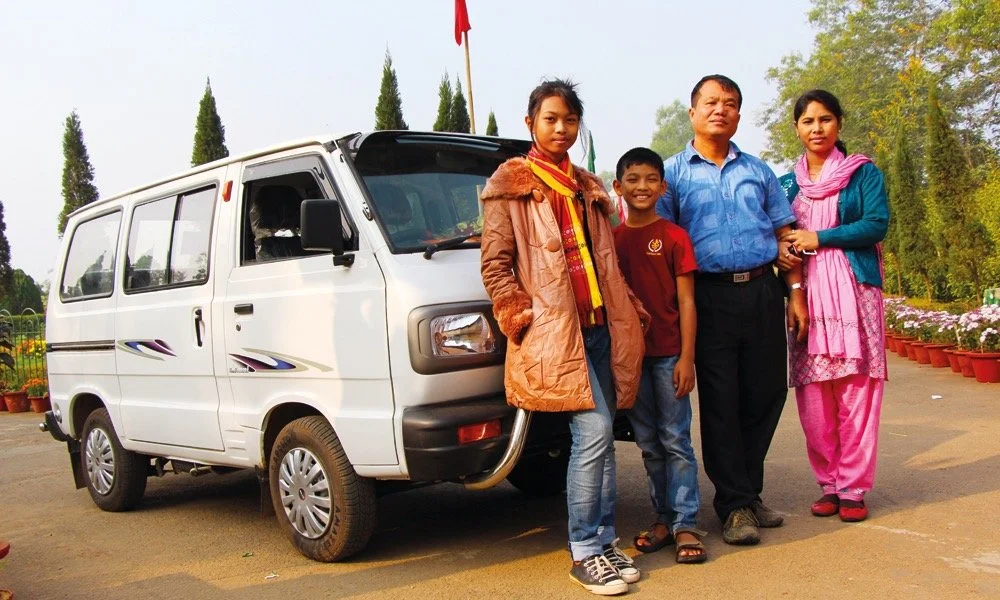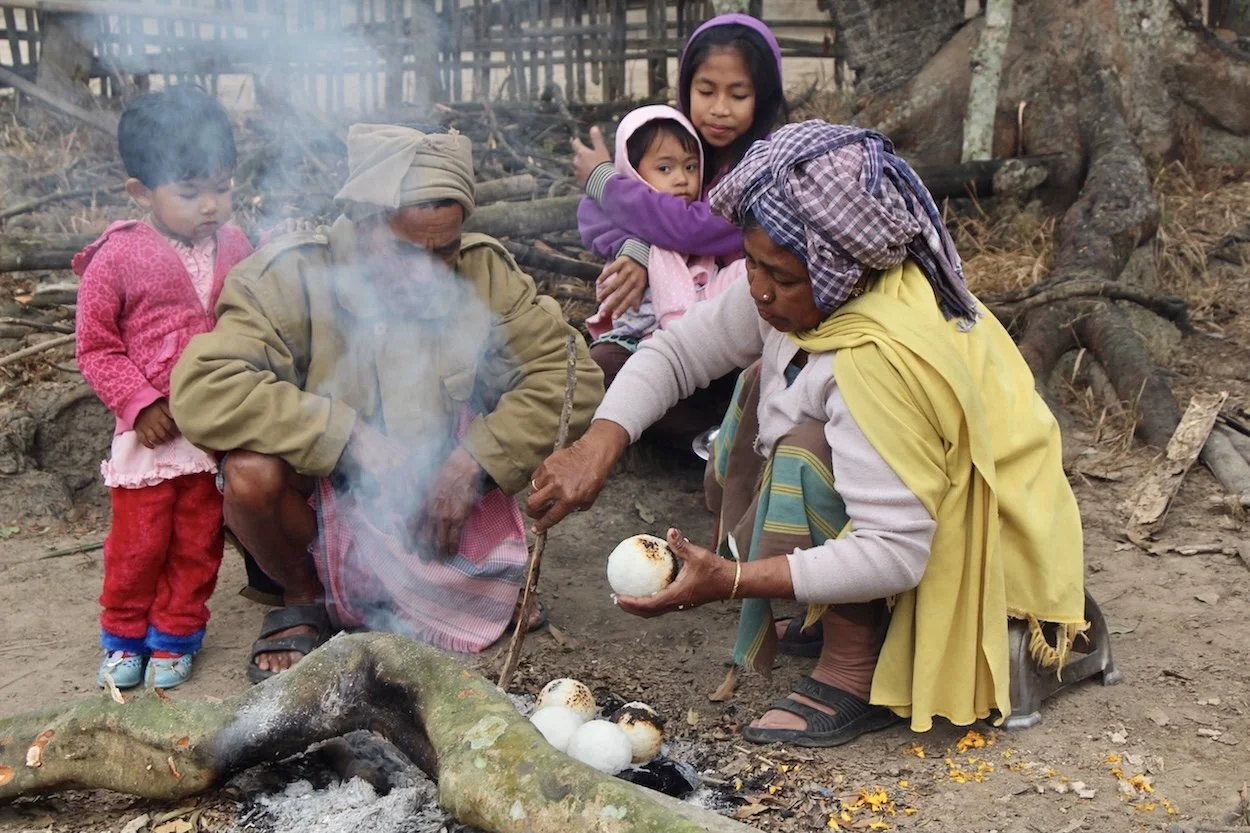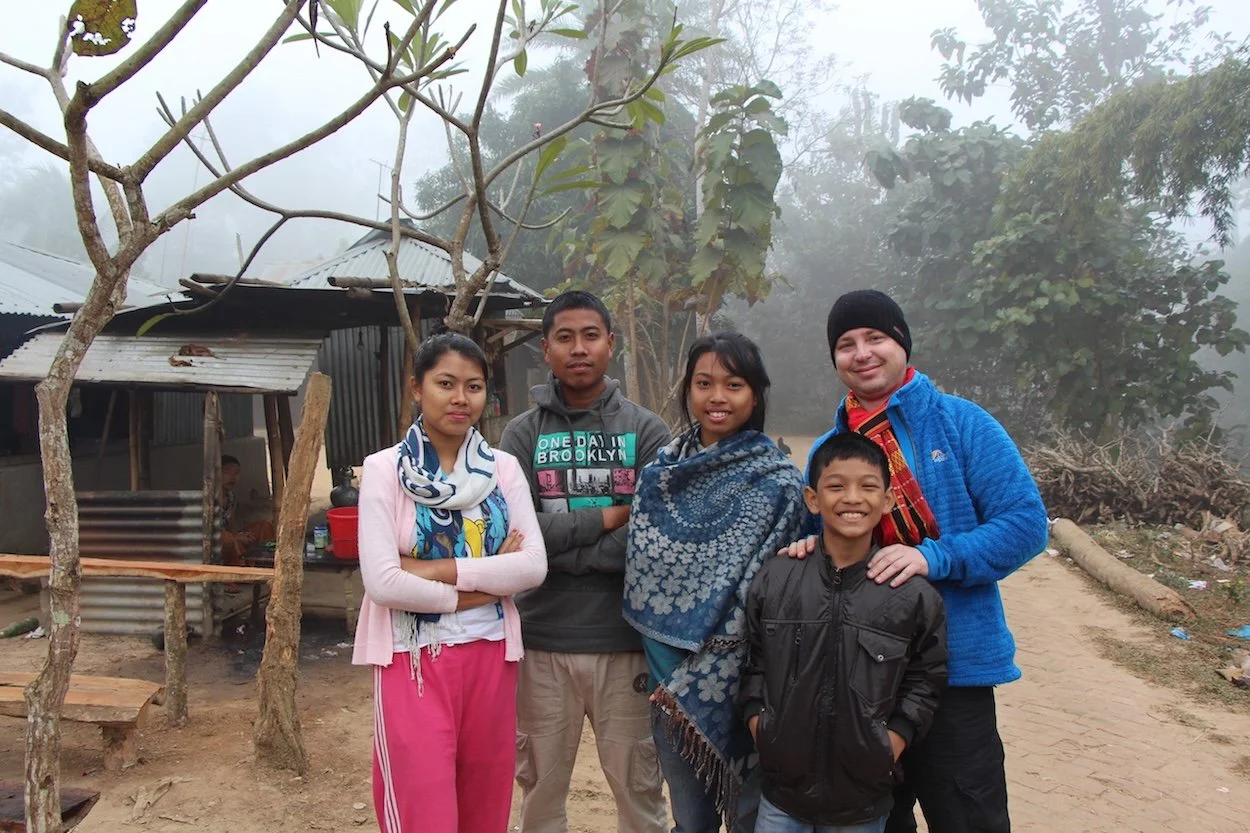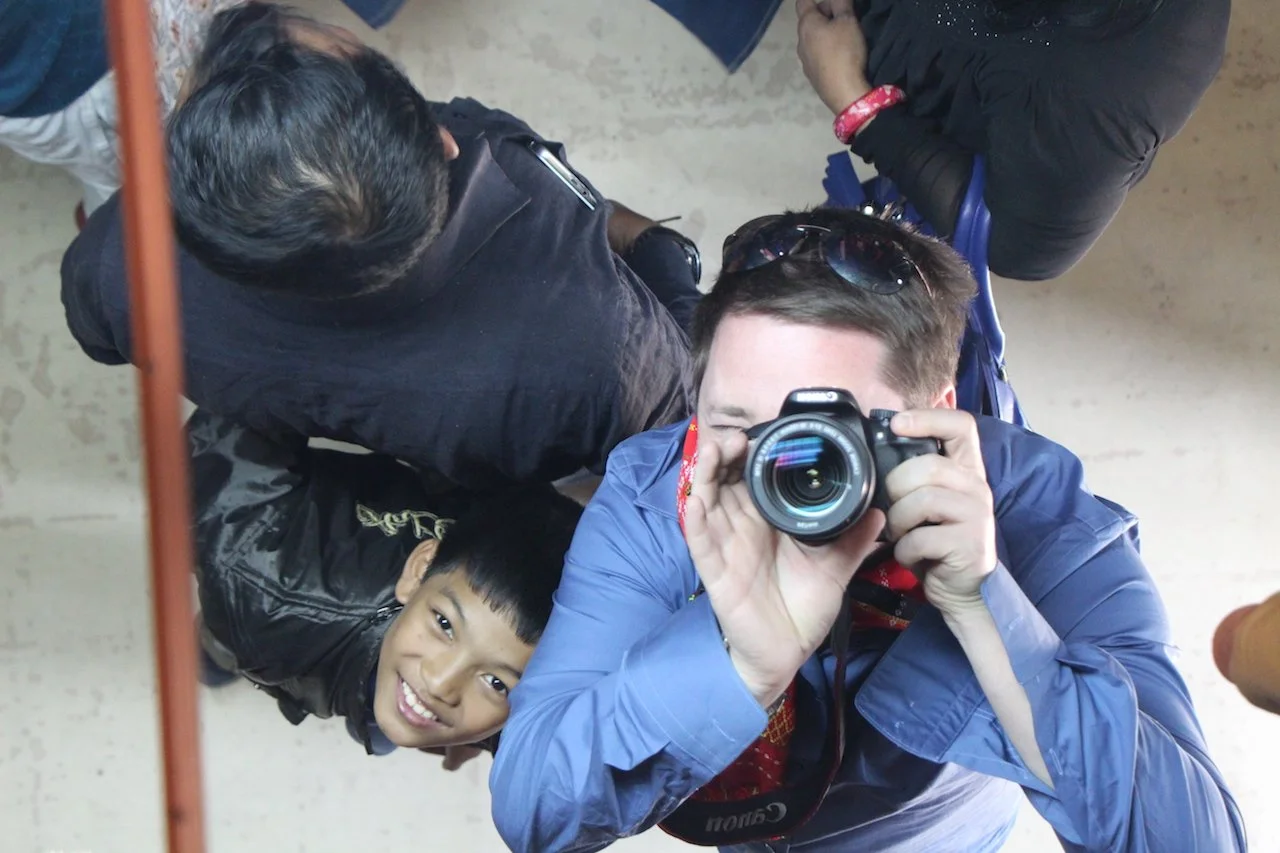Roadtripping the Seven Sisters: One Van, Five States, and a Thousand Small Stories (India)
This is the story of a journey through five of India’s Seven Sisters. Of rice wine toasts and jungle bathrooms, of mountain roads, roadside wisdom, and sacred traditions whispered over campfires. From Tripura to Nagaland, I was welcomed like a brother and sent home a little more human. Come along — but bring an open heart and don’t expect to stay unchanged.
Meet the crew: From left – Kherengbar, Baslang, Mina and Bijoy — the family that made this journey possible, standing proudly in front of the van just before the road trip began. No GPS, just heart, stories, and an extra bottle of arak in the glove compartment.
(This is a very brief description of a very long trip)
Bijoy drapes a “risha” around my neck — a traditional Tripuri scarf in red, yellow and black. It’s a symbolic gesture of welcome, and even I, with my rumpled backpack and mid-flight breath, manage to feel like a visiting dignitary. His wife Mina hands me a colourful bouquet of local flowers, and their children Kherengbar and Baslang greet me with a warm smile. I’ve just arrived in Tripura, one of India’s “Seven Sisters” in the northeast.
A few years ago, I rescued a girl from Nagaland at a swimming pool in Norway. Now, my old friend Bijoy had offered to drive the long and winding road from Tripura to Nagaland — so I could finally meet her father. The trip started by exploring the wonderful Tripura.
Bijoy insists on carrying my bag. “Mina thought you missed the flight,” he says. “She cried.”
Now, if someone cries because they thought you didn’t make it — that’s a good sign.
Bijoy and I met in Darjeeling years ago and kept in touch. Now, I'm here to meet his family and begin a journey I can’t quite believe I’m on: a road trip through five of the Seven Sisters, all the way to Nagaland — and a meeting I’ve long hoped for.
But we’ll get to that. Let’s start where all good stories begin: with a man, a village, and a suspicious amount of homemade rice wine.
“Cultural confession:
Mina packed a fork and spoon just for me. Apparently, word had spread that I wasn’t used to eating curries with my hands — something I’m not exactly proud of as an anthropologist (the whole point is to do as the locals do, right?).
But in that small gesture, I saw something much bigger: care, thoughtfulness, and the quiet kindness that follows you on every road in Tripura.”
Tripura: Where Guests Are Gods
The trip begins in the capital Agartala and later to Khumulwng and village life in Jampuijala. Bijoy´s father, Mr. Rajendra (80), is the kind of man who always has a project going on around the house. We don’t speak a word of each other’s languages — but sometimes you don’t need words. Heart-language is a thing, I swear.
There’s a saying — and a deeply held attitude — in Tripura: “The guest is a god.”
And trust me, this isn’t just something they say. It’s something you feel — in the way they pour your tea, if you know what I mean. It’s the kind of hospitality that bypasses language and lands straight in your chest. I’ll be forever grateful for being shown that this kind of humanity still exists — and that it thrives in the hills of Northeast India. The tripurian humbleness, humor and kindness is what the world needs.
We leave behind the chaos of Agartala to peaceful villages. Asphalt gives way to red sand roads winding through rice paddies, bamboo groves, and clusters of palm trees. I stick my hand out the window and let the breeze slap me awake.
This, my brain tells me, is why we travel. Freedom in action. Freedom in heart.
We are now in Mina´s village, Jamuijala. One of the most beautiful places I’ve been to. A classical natural beauty with the warmest people. Bijoy pours me a glass of arak — local rice wine that tastes like mildly aggressive sake — and toasts me in Kokborok.
“Hambai!”
“The man who invented this drink really understood our emotions, Bijoy laughs. Also, it helps with English.”
Speaking words of wisdom.
Bijoy’s worried, though. He admits he was nervous about me coming to Jampuijala. The houses are made of mud and cooking is made by fire.
“We don’t have houses like Norway. No hot water. The toilet is in the jungle.”
His wife had insisted I stay with them anyway. She wanted me to see how life is in rural Tripura.
She was, of course, entirely right.
For me, Jampuijala is by far better than any luxurious five-star hotel. I loved the kindness of the people, the nature surrounding the village, the quiet joy of sitting by the fire while cooking. The infamous jungle toilet turned out to be surprisingly delightful — more like a mini safari with a jungle view. Sure, it lacked modern plumbing… but it more than made up for it with birdsong, a breeze, and the kind of scenery you don’t usually get from a bathroom stall. It was perfect. Jampuijala and Tripura were some of the highlights and always in my heart.
Bijoy and I talk about faith. Tripuri people mostly follow Hinduism now, and many are also christians. But before that, their beliefs were rooted in nature: god in the trees, in the rocks, in the water. I personally feel very connected to this idea of animism and the respectful approach to nature. I tell Bijoy that I get a spiritual sensation here — under the stars, surrounded by nature and friends, talking with him after all these years, listening to the wind move through the trees. We are watching the fire give life to one of Mina´s many dishes.
“You’re right,” he says quietly. “We’re in heaven now. Hambai!”
Now the roadtrip starts. First place is Assam.
The article continues under the gallery.
Tripura travel photos (click and swipe to use the gallery):
Assam: A Drive-By Glimpse
Bijoy is captain of our noble steed — a white Maruti Suzuki van. I’ve been promoted to “co-pilot,” which mostly involves snacks and passive admiration. Bollywood music is playing loud. Google Teri Ore from Singh is Kinng to get the vibe.
We drive through Assam at dusk, watching tea plantations pass by like living paintings. Assam is beautiful but complicated. Bijoy warns it’s not safe to linger — ethnic tensions, conflict with Bangladeshi migrants. So I see it through the window. A green blur of beauty and burden.
Sometimes, glimpses are enough to stir the soul.
Along the road :
Meghalaya: Scotland With Menthols
We roll into Shillong at sunrise, after a punishing all-night drive. The hills are pine-covered and impossibly cinematic. The British built Shillong as a hill station during colonial times — and it shows.
We eat toast and boiled eggs at Bijoy’s aunt’s place. I take a moment to recharge at the Royal Heritage Tripura Castle (yes, that’s a thing). It has hot water and a fireplace. I almost weep. The Tripura Castle Hotel in Shillong is named after the royal family of Tripura, who built it as their summer residence during the time of the Maharajas. Today, it's a heritage hotel — perched on a quiet hilltop — where colonial charm meets Northeast India’s regal past. But no time to linger. Today we sightsee. Shillong Peak gives us a view of the whole city. We drink tea. Smoke menthols. Whisper a few reflective things. Snap some photos.
At Wards Lake, we watch young couples flirt awkwardly under trees. In conservative India, parks are the unsupervised teenage bedrooms of romance.
We turn in early. Tomorrow we’re heading to Cherrapunjee, allegedly the wettest place on Earth. The staff lit the fireplace in my room before I drifted off — a perfect ending to a long day of winding roads and wonder.
Meghalaya travel photos (click and swipe):
Manipur: Denim Dreams and Political Dread
In Manipur, we’re staying with old friends of Bijoy’s in the village of Motbung. His house is bright green and plastered with Jesus posters. As in every place we visit, the welcome unfolds with a warmth that leaves the West feeling distant and formal. Here, I’m not a guest — I’m embraced like family. However, there are some political tensions in the area.
“Don’t go out alone,” they warns. “It’s not safe. Republic Day is coming. Perfect timing for rebels.”
Right.
Military checkpoints dot the road.The soldiers at the checkpoints were often especially curious about why a white foreigner was traveling through these parts — but the encounters always ended with a smile, a nod, and a wave through. We visit Imphal’s Khwairamband Bazaar, where 3000 women run the market. We stop by a mustard field, pose with locals, and marvel at Loktak Lake. In Manipur, women have long held powerful roles — as market leaders, activists, and community anchors — which may be why they walk with a confidence that feels both rooted and refreshingly free.
But the real highlight? Helping Mina buy her first pair of jeans. Her eyes shining with a mix of excitement and quiet pride. I’m not sure how often she’s worn them since — jeans aren’t exactly standard attire for women in Tripura — but in that moment, she wore them like a quiet revolution.
Caption: Khwairamband Bazaar in Imphal. Old women selling tobacco made in traditional way. Photo: Frank Hansen
More travel pictures from Manipur. Click and swipe to use the gallery.
Nagaland: Finally, Kaka
Nagaland has long been on my map — and in my heart. We drove the winding hills up to Kohima under a full moon, the van humming like a tired bumblebee. Somewhere along the way, Bijoy and I got talking about past lives — whether we might’ve known each other before, or if some mysterious force had nudged our paths together. As conversations go, it felt strangely fitting for a moonlit climb into the clouds.
It was well past midnight when we rolled into town, only to discover that Kohima goes to bed early. Everything was closed. Every hotel we tried was full. Our bodies were ready to collapse into something horizontal, but it looked like we’d be spending the night in the van, two semi-philosophical nomads and family under a Naga sky.
And then, a twist: I remembered I had one friend from Nagaland on Facebook. Just one. That was all it took.
She had a friend — naturally — who was a bamboo architect (because of course he was) and, even more naturally, he had a big house. Despite the late hour, he and his family got out of bed, welcomed us in, made tea, and even served snacks before showing us to our rooms.
Once again, the people of Northeast India showed a kind of hospitality that makes the rest of the world feel like it’s missing a page in the manual.
I came here to meet Kaka, the father of a girl I once rescued from drowning in Norway. But when when we woke up to our first day in Kohima, we learn he’s sick and can’t see us. My heart drops. However, we met his son that brought us to Khonoma village to stay a couple of nights.
Khonoma is a hilltop village in Nagaland known for its fierce resistance to British colonists and its deep-rooted warrior traditions. Today, it stands as a symbol of resilience, community wisdom, and harmony with nature — where ancient rice terraces ripple down the valley like green echoes of the past.
Kaka was still sick and we got ready to get back to Tripura. But then, a twist. Again.
The phone rings. It’s Kaka. He wants to see me.
When I arrive, he hugs me. Hugs aren’t common here. He thanks me for saving his daughter. He talks about water, and failure, and forgiveness. And then:
“Frank,” he says. “You are my son now.”
Kaka is an author. He signs two books for me and gave me a traditional shawl from Nagaland. We hug again. And just like that — the road trip is no longer just a road trip.
The article continues under the gallery.
Nagaland travel photos (click and swipe to use the gallery):
Final Reflections (With Arak and Gratitude)
This journey through the Seven Sisters wasn’t just about landscapes or temples or road snacks. It was about people. About learning how others live, what they believe, and what they hope for.
From rice wine fireside chats to denim dreams in Manipur, from flirty parks in Shillong to political slogans carved in stone — it was a ride.
And now I know: the heart speaks fluently, even where language fails.
So here’s to Bijoy and Mina, Kherengbar and Baslang, to arak and muddy roads, to rebel checkpoints and mountain views — and to a man who told me I was his son.
That’s one road I’ll never forget.



































































































